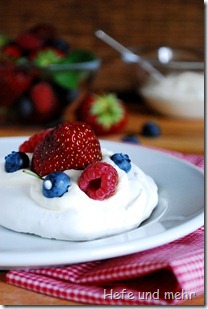 Why did I wait so long until I tried this recipe? I don’t know! It is a simple recipe with three components that promise dessert heaven on earth: Meringue, cream and fresh fruits. And like Eton Mess the magic of pavlova consists of this mixture of crunchy and soft, sweet and sour and this made the dessert irresistible.
Why did I wait so long until I tried this recipe? I don’t know! It is a simple recipe with three components that promise dessert heaven on earth: Meringue, cream and fresh fruits. And like Eton Mess the magic of pavlova consists of this mixture of crunchy and soft, sweet and sour and this made the dessert irresistible.
I saw Pavlovas on many food blogs before: Claudia bake them, and Paule, Nicky and Barbara made them some time ago, too. And every time I read one of their posts I thought: I have to try this! But I didn’t do it until this weekend. When we bought some delicious berries (strawberries, blueberries and raspberries) I decided that they would be great for a pavlova.
I like the miniature version of the dessert that Claudia bake and so I decided to do single portion pavlovas with a diameter of only 10 cm and a little pit in the middle to keep the cream.
The recipe is really simple only waiting for the meringue to bake/dry takes some time. And you will be rewarded with a delicious dessert for your patient waiting! A great recipe for the summer!
Pavlova
yields 4 small Pavlovas
Meringue
- 2 egg whites
- 100g sugar
- 1 Tsp. vinegar
Filling
- 100g cream
- 15g sugar
- 200g Berries of the season
Whip egg whites until soft peaks. Add the sugar gradually and whip until the sugar is dissolved. At the end add the vinegar.
Using a tablespoon form four round merinuges with a diameter of about 10 cm with a little pit in the middle.
Bake at 120°C for one hour. Let cool down after baking.
Whip the cream with sugar until soft peaks, put it on the meringue and decorate with berries. Serve immediately.
Deutsch



Stephanie, I have been reading and reading. I now know what the pate fermentee is!! The recipe directions weren’t in english until I got to the pastry cream. I shall find someone to translate for me. I took German in high school, but that was too long ago! Thank you for getting back to me! Jan
@Jan o’leary: I just checked in the recipe. Very strange that a part of the english description vanished, maybe it happens when we moved the blog last month. I have corrected it, so I hope everything is now fine again 😀
Do you know the history of this dish?
@Vic: It’s said that it was created either in New Zealand or in Australia in the 1920s to honour Anna Pavlova.
sicher ne dumme Frage, aber was nimmt man das für Essig?
Wills mir ja nicht vers…en :-).
@Julia: Es gibt keine dummen Fragen 😉 Ich habe einen milden Weißweinessig genommen.
“Warum habe ich eigendlich solange gebraucht, um dieses Rezept nachzubacken?” genau diese Frage habe ich mir beim ersten Bissen auch gestellt 😉 Ein Traum von einem Dessert, mit dem man wirklich jeden Gast überzeugen und begeistern kann. LG